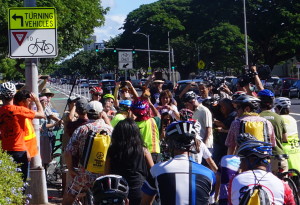I had always considered Shared Lane Markings, or sharrows, a cop-out, something that localities add when they want to look like they’re doing something to enhance cycling infrastructure but don’t want to make any actual changes. My cousin recently sent me this article, which in turn was based on this study that compared ridership and injuries before and after the addition of bike lanes or sharrows. Based on data about bike commuters in Chicago, the study found that the addition of bike lanes led to an increase in ridership and a decrease in injuries, while the addition of sharrows led to minimal changes compared with roads that had no changes in markings.
This started me thinking about sharrows in a larger context, and wondering whether they could have a negative impact on cyclists. For example, Hawaii law grants a bicycle the same rights as a car on a roadway (§291C-142). However, would sharrows on some roads lead drivers to the mistaken belief that cyclists are not allowed to ride on other roads that don’t have them? After giving this some thought, I’m of the mind that sharrows can be useful when used appropriately, but we shouldn’t consider them a major infrastructure improvement.


